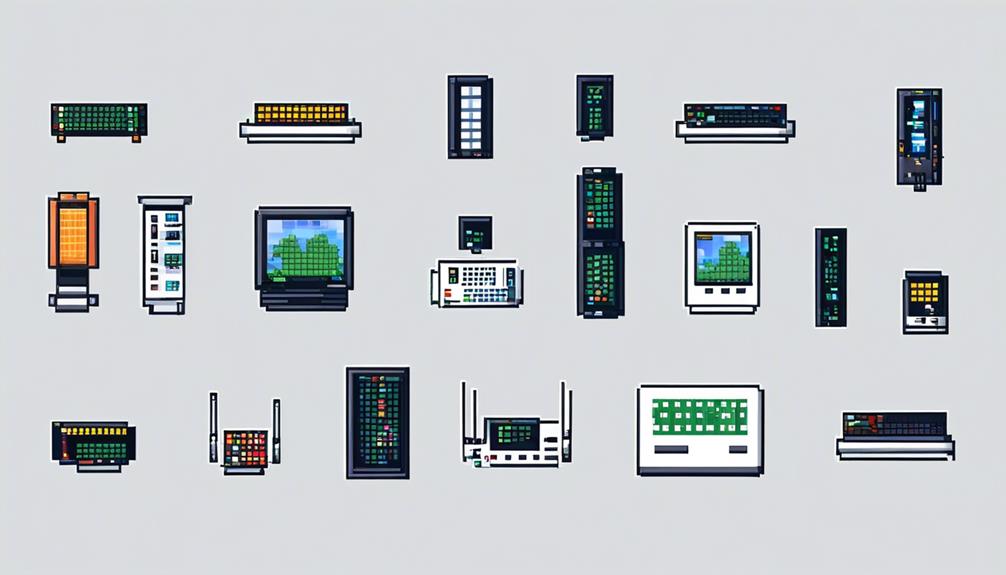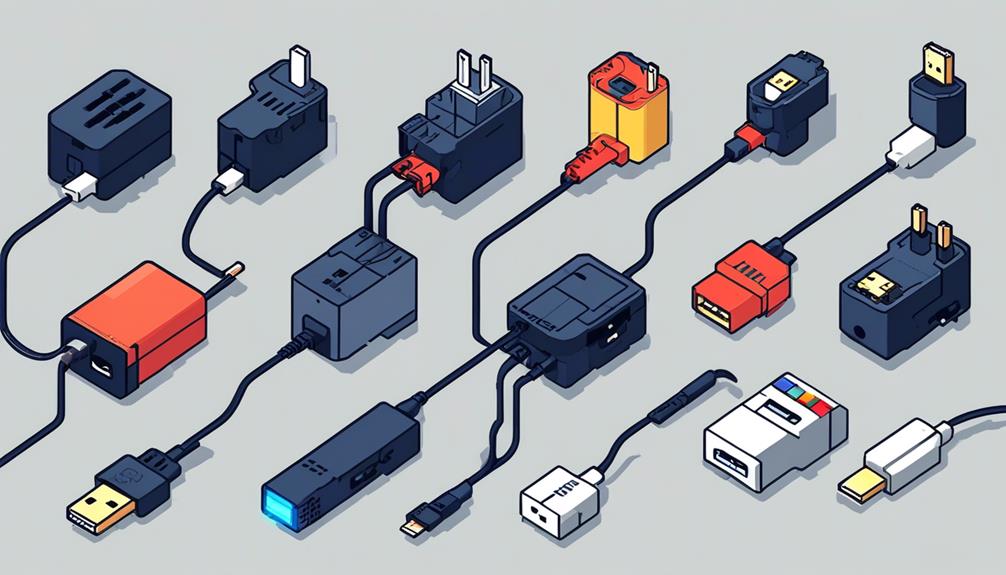Long-range wireless communication has become increasingly essential in today's interconnected world, where IoT devices and smart applications are proliferating.
To enable seamless communication over vast distances while conserving power, specialized hardware has emerged. This hardware includes a range of devices and components designed for specific applications like IoT, smart cities, industrial automation, and agriculture. With options such as LoRaWAN, Sigfox, Wireless M-Bus, KNX-RF, and Wi-Sun, these hardware solutions offer reliable connectivity and support the development of robust IoT ecosystems.
However, the intricacies of selecting the right hardware, understanding wireless compatibility, and considering mechanical design elements can be overwhelming. In this discussion, we will explore various aspects of hardware for long-range wireless communication, including wireless modem options, USB interface compatibility, configuration and setup, mechanical design considerations, wireless compatibility notes, magnetic attachments for easy installation, wireless interface options for IoT sensors, and insights from the community.
Join us as we delve into the fascinating world of long-range wireless communication hardware and uncover the key factors to consider for successful deployments.
Key Takeaways
- LoRaWAN, Sigfox, Wireless M-Bus, KNX-RF, and Wi-Sun are wireless modem options that offer long-range connectivity for IoT and M2M applications.
- The low power consumption of these wireless modems allows for extended device operation without frequent battery replacements.
- Support for mesh networks creates a self-healing and robust network infrastructure for reliable communication.
- Proper equipment selection, antenna positioning, and network optimization techniques are crucial for optimal performance and compatibility in long-range wireless communication setups.
Wireless Modem Options

Wireless modems, such as LoRaWAN, Sigfox, Wireless M-Bus, KNX-RF, and Wi-Sun, offer long-range connectivity with low power consumption for IoT and M2M applications. These wireless modems are designed to provide seamless wireless communication for a variety of IoT devices.
One of the key features of these wireless modems is their long-range capability, allowing devices to communicate over large distances. This is particularly useful in applications such as smart city implementations, where devices may be spread out across a wide area. The long-range capability ensures that all devices within the network can stay connected and exchange data efficiently.
In addition to long-range communication, these wireless modems also offer low power consumption. This is crucial for IoT devices that may be running on batteries or other low-power sources. By minimizing power consumption, these modems enable devices to operate for extended periods without the need for frequent battery replacements or recharging.
Another important feature of these wireless modems is their support for mesh networks. Mesh networks allow devices to communicate with each other directly, creating a self-healing and robust network infrastructure. This ensures that even if one device fails or is out of range, the network can still function effectively.
Furthermore, these wireless modems are designed to support both wired and wireless node topologies. This flexibility allows for easy integration into various IoT applications, regardless of the existing infrastructure.
USB Interface Compatibility
The USB interface compatibility of these wireless modems allows for seamless integration into various IoT applications, providing a convenient and efficient means of communication. With the ability to mount as a Virtual COM Port, these modems can easily connect to IoT devices, enabling long-range wireless communication up to 2 miles. The programmable baud rate further enhances the flexibility and adaptability of these wireless modems.
One of the key advantages of the USB interface compatibility is the ease of use. Users can simply plug in the modem, open the COM port, and start sending commands. This simplifies the setup process and reduces the time required for implementation. Additionally, the compatibility with all 900HP-S3B devices ensures interoperability and seamless communication within a wireless mesh network.
When it comes to IoT devices, the USB interface compatibility is particularly valuable. IoT devices often require wireless communication technology that can support long-range connectivity, and these modems provide a reliable solution. Whether it is for industrial automation, environmental monitoring, or smart city applications, the ability to communicate wirelessly over long distances is crucial.
It is important to note that the USB interface compatibility is specific to NCD Industrial Products. Compatibility notes apply to these devices, and users should ensure that their IoT devices are compatible with the specific wireless modems they choose.
Configuration and Setup

When configuring and setting up long-range wireless communication hardware, there are several important points to consider.
First, equipment selection is crucial in ensuring optimal performance and compatibility with other devices.
Second, antenna positioning plays a significant role in maximizing signal strength and range.
Finally, network optimization techniques, such as adjusting transmission power and channel selection, can further enhance the overall performance of the wireless communication system.
Equipment Selection
To ensure successful configuration and setup of long-range wireless communication hardware, it is crucial to carefully consider the specific requirements and compatibility of the equipment with various devices and systems.
Here are some key factors to consider when selecting the equipment:
- Understand the wireless communication options available and choose the appropriate frequency for your target region and application.
- Identify the compatibility of the equipment with different devices and systems to ensure seamless integration.
- Ensure the availability of resources such as mechanical drawings and specifications to facilitate proper setup.
- Verify the purchasing details including lead time, pricing, and product identification for acquiring the equipment.
- Pay attention to the antenna options provided, as the right antenna can greatly enhance the range and performance of the wireless communication system.
Antenna Positioning
Having selected the appropriate equipment for long-range wireless communication, the next critical step is to carefully configure and set up the antennas for optimal positioning. Antenna positioning plays a crucial role in maximizing the signal strength and coverage of a Long-Range Wireless Mesh or IoT network.
To begin, it is essential to understand the environment and identify potential obstacles that may obstruct the signal. Once this is done, the antennas should be placed at an optimal height and orientation to minimize interference and maximize transmission range.
Regular testing and adjustment of antenna positioning may be necessary to achieve the best results.
Network Optimization
Network optimization involves the meticulous configuration and setup of wireless communication devices to ensure maximum efficiency and seamless machine-to-machine communication for IoT applications.
To achieve this, several factors need to be considered:
- Wireless Mesh Communications: Implementing a wireless mesh network allows for better coverage and improved reliability by creating multiple paths for data transmission.
- XBee-Pro: Choosing the right hardware, such as the XBee-Pro module, enables long-range wireless communication with low power consumption, making it ideal for IoT applications.
- Product Options: Selecting the appropriate products, such as the RP-SMA Pigtail Cable and GHz Dipole Antenna, can enhance the range and signal quality of the wireless communication system.
- Gateway Configuration: Proper configuration of the gateway plays a crucial role in connecting the wireless devices to the internet and managing the flow of data.
- Module Settings: Optimizing the module settings, such as data rate, transmission power, and channel selection, ensures optimal performance and minimizes interference.
Mechanical Design Considerations

Considerations for the mechanical design of long-range wireless communication hardware include:
- Physical dimensions, form factor, and environmental durability to ensure seamless integration and long-term outdoor deployment.
When developing hardware for Long-Range Wireless Mesh (LRWM) communications, it is crucial to carefully select the physical dimensions and form factor to support the intended use cases. The hardware should be compact and lightweight to facilitate easy integration into various systems, such as Internet of Things (IoT) devices, without compromising functionality. Additionally, the mechanical design should optimize space utilization and allow for efficient placement of internal components.
To ensure long-term outdoor deployment, the mechanical design should address environmental durability. The hardware should be designed to withstand harsh environmental factors, including extreme temperatures, humidity, and vibration. This is particularly important for LRWM products intended for deployment in remote or industrial settings where the environmental conditions may be challenging. The use of ruggedized materials and protective casings can enhance the hardware's ability to withstand these conditions and ensure reliable performance over an extended period.
Furthermore, the mechanical design should enable easy maintenance, repair, and replacement of components in the field. This minimizes downtime and reduces the need for specialized technical support, making the hardware more user-friendly and cost-effective. Secure mounting and grounding features should also be incorporated into the design to prevent damage from external factors, such as strong winds or accidental knocks, and ensure stable operation.
In addition to functionality and durability, the overall aesthetics and physical interface of the hardware should be considered. The design should align with user preferences and usability requirements, ensuring that the hardware is visually appealing and intuitive to use.
Wireless Compatibility Notes
The Wireless Compatibility Notes for the 900HP-S3B Wireless module are relevant to NCD Industrial Products, including Fusion, ProXR, ProXR Lite, Taralist, and Reactor Series Products. It is important to note that these compatibility notes do not apply to NCD Enterprise Solutions, NCD Wireless Sensors, and NCD Enterprise Modems and Gateways.
To configure the module settings, it is necessary to use the ZIGMO_PCB. It is also worth mentioning that long-range wireless sensors can be programmed over the air without removing the communications module.
Additionally, communication with the 900HP-S3B module or a compatible gateway can only be established through a 900HP-S3B Modem.
Wireless Standards
Optimized for machine-to-machine communication, wireless standards such as LoRaWAN, Sigfox, Wireless M-Bus, KNX-RF, and Wi-Sun provide long-range connectivity with low power consumption for IoT applications.
These standards are ideally suited for smart city initiatives, industrial automation, and various IoT deployments. Offering secure and reliable wireless mesh networks, these standards ensure interoperability between devices and systems.
To ensure compatibility, specific products and configurations may be required, such as using ZIGMO_PCB for 900HP-S3B modules or a 900HP-S3B Modem for communication.
With their long-range capabilities and low power consumption, these wireless standards enable seamless connectivity and data transmission for a wide range of IoT devices including wireless sensors.
Device Compatibility
To ensure seamless integration with the wireless network, it is essential to consider the device compatibility and wireless compatibility notes for the 900HP-S3B Wireless Modem and specific NCD Industrial Products. These compatibility notes apply to Fusion, ProXR, ProXR Lite, Taralist, and Reactor Series Products.
It is important to use the ZIGMO_PCB to configure module settings for long-range wireless sensors, and remember that a 900HP-S3B Modem or compatible gateway is required for communication. However, it is worth noting that compatibility notes do not apply to NCD Enterprise Solutions, NCD Wireless Sensors, and NCD Enterprise Modems and Gateways.
The 900HP-S3B Modem or compatible gateway is necessary for communication, ensuring that the device seamlessly integrates with the wireless network. This compatibility ensures reliable and efficient long-range wireless communication, maximizing penetration and optimizing battery life for IoT devices.
Power Adapter and Cable Options

Are there various power adapter and cable options available for powering and connecting Lo-Fi devices? Absolutely! When it comes to long-range wireless sensors and communication, having the right power adapter and cable options is crucial for seamless operation. Here are five key options to consider:
- Cable Type: Depending on the specific requirements of your setup, you can choose from a variety of cable types such as USB, Ethernet, or coaxial cables. Each type offers different benefits and is compatible with specific interfaces.
- Version of Product Currently in Use: It is essential to consider the version of the Lo-Fi device you are using. Different versions may require specific power adapters and cables to ensure compatibility and optimal performance.
- Choosing a Wireless Option: If you prefer a wireless setup, you can opt for a power adapter and cable that support wireless connectivity. This allows for greater flexibility in terms of device placement and eliminates the need for physical connections.
- Module Settings: Some power adapters and cables come with adjustable module settings, allowing you to fine-tune the power supply to meet the specific requirements of your long-range wireless communication setup.
- Long-Range Wireless Communication: When selecting a power adapter and cable, make sure they are designed to support long-range wireless communication. This ensures reliable and stable power supply over extended distances.
Commercial Door Sensor Solutions
Commercial door sensor solutions play a vital role in ensuring reliable monitoring and enhanced security for commercial spaces, seamlessly transitioning from the discussion on power adapter and cable options for long-range wireless communication. These solutions are an essential part of the Internet of Things (IoT) ecosystem, enabling real-time detection and alerting of the opening and closing of doors in commercial environments.
One of the key features of commercial door sensor solutions is their long-range wireless communication capabilities. This allows for seamless connectivity over large commercial areas, ensuring that the sensor data can be transmitted to the central monitoring system without any interruptions. With the ability to cover significant distances, these sensors can effectively monitor multiple doors in a building or across different locations.
Commercial door sensor solutions are designed to be hardware optimized for low power consumption. This is crucial for long-term, energy-efficient operation, as commercial spaces often require constant monitoring. By minimizing power usage, these sensors can function for extended periods without the need for frequent battery replacements or recharging, ensuring continuous security and access control.
These sensor solutions are widely used in various industries such as retail, warehouses, and office buildings. They provide enhanced security and access control by detecting unauthorized access or tampering. Moreover, commercial door sensor solutions can be integrated into larger sensor networks, allowing for comprehensive monitoring and management of commercial spaces.
IoT Sensor Transmission Interval

The IoT sensor transmission interval is a critical parameter that determines the frequency at which data is sent, based on preset timing intervals. This parameter plays a crucial role in ensuring efficient and timely transmission of data in long-range wireless sensor applications.
Here are some important considerations regarding the IoT sensor transmission interval:
- Data transmission based on count threshold: In addition to preset timing intervals, data can also be sent when a count threshold is reached. This ensures that relevant information is transmitted promptly, without unnecessary delays.
- Customizable transmission patterns: Advanced module settings allow users to adjust reporting interval and count threshold, enabling customization of the transmission pattern according to specific application requirements. This flexibility ensures optimal utilization of wireless communications resources.
- Visualization of transmission behavior: The use of LabVIEW software facilitates the visualization of input counts over time. This feature provides valuable insights into the behavior of data transmission, aiding in the optimization of the IoT sensor transmission interval.
- Outdoor applications and extreme temperature conditions: It is important to note that the predetermined transmission interval may not be suitable for outdoor applications or extreme temperature conditions. Factors such as environmental interference and power consumption should be taken into account when determining the appropriate transmission interval for these scenarios.
- 900MHz option for extended transmission range: Long-range wireless sensors often offer a 900MHz option, which provides an extended transmission range compared to other frequency bands. This option allows for seamless communication over longer distances, making it suitable for applications that require extensive coverage.
Magnetic Attachments for Easy Installation
Magnetic attachments for easy installation offer a simple and convenient process for setting up wireless communication devices. These attachments provide a secure and flexible way to mount the devices in various locations without the need for complex mounting hardware or tools.
With their easy setup and removal, magnetic attachments streamline the deployment process, ensuring quick and effortless installation.
Simple Installation Process
With a simple and efficient installation process, the long-range wireless communication hardware offers convenience and flexibility through the use of magnetic attachments. This innovative feature allows for quick and hassle-free setup, eliminating the need for complex tools or mounting hardware.
The magnetic attachments ensure secure and stable installation, providing peace of mind for users. Additionally, the simplicity of the installation process allows for easy repositioning or relocation of the long-range wireless sensors as needed.
Whether you are setting up IoT Long Range devices or need help choosing the right equipment for your specific requirements, the magnetic attachments make the installation process a breeze. These attachments also enable the hardware to penetrate objects, such as walls or doors, without compromising the signal strength.
For a seamless and reliable long-range wireless communication system, we strongly suggest considering a gateway of some kind to further enhance the installation process.
Convenient Magnetic Attachments
Featuring a user-friendly design, the long-range wireless communication hardware offers effortless installation through the use of convenient magnetic attachments.
Designed by NCD Products, a leading provider of IoT solutions, these magnetic attachments enable seamless integration with a wide range of embedded devices, control devices, and smart metering systems. With these attachments, complex mounting hardware is no longer required, simplifying the installation process.
The magnets provide stable and secure attachment, ensuring reliable long-range wireless communication between devices. Additionally, the magnetic attachments allow for flexible positioning and repositioning, enhancing user convenience and adaptability.
Whether it's for long-range wireless sensors or other IoT applications, the use of magnetic attachments provides a hassle-free solution for quick and easy installation of the hardware.
Easy Setup and Removal
The user-friendly design of the long-range wireless communication hardware simplifies the installation process by offering easy setup and removal through the use of innovative magnetic attachments. This feature eliminates the need for additional tools or complex procedures, allowing for quick and convenient mounting and unmounting of the hardware.
The magnetic attachments provide a secure and stable connection, ensuring reliable operation. They also enable flexibility in positioning and relocating the hardware as needed to achieve optimal performance. Additionally, these magnetic attachments facilitate seamless integration with various devices, enhancing user convenience and adaptability.
With the option for 900MHz frequency, the hardware is certified for use worldwide, further expanding its usability. Users can easily configure the module settings to meet their specific requirements.
It is important to note that photos may not be shown during the purchasing process.
Wireless Interface Options for IoT Sensors
Wireless interface options for IoT sensors encompass a range of technologies tailored to diverse applications and requirements.
Long-range wireless sensors are an essential component of the Internet of Things (IoT) ecosystem, enabling communication between devices over extended distances. In order to meet the specific needs of IoT applications, various wireless interface options are available.
One such option is LoRaWAN, which offers long-range connectivity with low power consumption. This makes it ideal for machine-to-machine communication in smart city and industrial automation applications. LoRaWAN products provide optimized connectivity, helping to extend the reach of IoT devices.
Another option is Sigfox, which operates a global network capable of listening to billions of devices. Sigfox products are specifically designed for low-power, wide-area IoT applications such as asset tracking and remote monitoring. With its wide coverage and low energy consumption, Sigfox can help meet the wireless interface needs of IoT sensors.
Wireless M-Bus is another technology rapidly spreading in Europe for meter reading applications. It enables automatic reading of electricity, gas, water, and heat meters with high reliability and efficiency. Wireless M-Bus products offer a wireless interface option that ensures seamless integration of IoT sensors into metering systems.
For building automation systems, the KNX-RF standard provides wireless interface options that support both wired and wireless node topologies. This ensures high interoperability and eliminates the need for a central gateway. KNX-RF products are well-suited to help integrate IoT sensors into building automation systems.
Lastly, Wi-Sun products offer secure wireless mesh networks, making them ideal for municipalities and enterprises in need of multi-service networks. Wi-Sun ensures interoperability and security in wireless mesh networks, providing a reliable wireless interface option for IoT sensors.
When selecting wireless interface options for IoT sensors, it is important to consider the specific needs of the application. The technologies mentioned above can help meet these needs and provide reliable wireless communication for IoT sensors.
Exploring LoRa for Long-Range Communication

LoRa, a wireless communication technology for LPWANs in M2M and IoT applications, provides long-range connectivity with low power consumption. It is an optimal solution for long-range wireless sensors that need to transmit data over large geographic areas.
Here are some key points to consider when exploring LoRa for long-range communication:
- Transmission Range: LoRa technology offers an impressive transmission range, allowing devices to communicate over distances of up to several kilometers in urban areas and even tens of kilometers in rural areas. This makes it suitable for applications that require long-range connectivity.
- 900MHz Option: LoRa operates in the 900 MHz frequency band, which provides better penetration through obstacles and buildings compared to higher frequency bands. This makes it a reliable choice for communication in urban environments where signal interference can be an issue.
- Legal Options: LoRa operates within the unlicensed ISM bands, which means no licenses are required to use this technology. This makes it an attractive choice for businesses and individuals looking for cost-effective communication solutions.
- ISO9001:2015 Certified: LoRaWAN products, such as those offered by ST, are ISO9001:2015 certified. This certification ensures that the products meet international quality standards, giving users confidence in their reliability and performance.
- Wide-Area Networks (LPWANs): LoRa is a key technology in the development of LPWANs, which are designed to provide connectivity over large areas with low power consumption. By leveraging LoRa for long-range communication, businesses and industries can build robust and scalable networks to support their IoT applications.
Insights From the Community
When considering the implementation of LoRa for long-range communication, it is valuable to gather insights from the community to gain a deeper understanding of its real-world applications and potential. The community has shown significant interest in long-range wireless communication devices, as demonstrated by the support received by the Kickstarter campaign for the Lo-Fi device by Om Singh. With 129 backers pledging £12,085, it is evident that there is a strong demand for such hardware.
One company that offers a range of long-range wireless sensors is NCD Products. Their enterprise series provides a versatile solution for IoT and M2M applications. These sensors are optimized for low power consumption and have a wide transmission range. The latest version of the product features a 900MHz Antenna with RP-SMA, ensuring reliable and long-range communication.
To stay up to date with the latest advancements in long-range wireless communication, it is crucial to choose products that are RoHS compliant and legal for use. The 900HP-S3B Wireless Modem, for example, enables wireless control up to 2 miles from the USB port on a computer. This offers a convenient and versatile solution for long-range communication.
Additionally, the option to have the devices programmed over the air is an attractive feature. This allows for easy updates and configuration changes without the need for physical access to the device.
Frequently Asked Questions
What Is Used for Long Range Wireless Communication?
Long-range wireless communication relies on technologies such as LoRa, Sigfox, Wireless M-Bus, KNX-RF, and Wi-Sun. These technologies enable connectivity over long distances while minimizing power consumption. They are commonly used in various applications, including smart city infrastructure, industrial automation, smart metering, and building automation.
To achieve long-range wireless communication, these technologies incorporate advanced antennas and employ techniques to optimize data rates, signal strength, and minimize interference. Efficient power consumption is also a key consideration in these systems.
What Is the Maximum Range of Wireless Communication?
Factors affecting the range of wireless communication include frequency, interference, signal strength, and obstacles in the environment. Achieving long-range wireless communication can be challenging due to these factors, as well as the need to balance power consumption and data transmission speed.
Applications for long-range wireless communication range from smart cities and industrial automation to agriculture and logistics.
Strategies to extend the range include using higher frequency bands, optimizing antenna design, and employing signal amplification techniques.
Future advancements in long-range wireless communication technology aim to improve range, data rates, and power efficiency.
Which Radio Type Supports Long Range Communications?
When it comes to long-range wireless communication, several factors need to be considered.
Antenna selection plays a crucial role in optimizing signal propagation and ensuring maximum range.
Power requirements must be carefully balanced to achieve optimal performance.
Interference mitigation techniques are essential to maintain a strong and reliable connection.
Data rate considerations are important for efficient transmission of information.
Lastly, regulatory considerations must be taken into account to comply with local regulations and ensure seamless operation.
These factors collectively determine the radio type that supports long-range communications.
Which of the Following Are Long Range Wireless Iot Technologies?
Long-range wireless IoT technologies include LoRaWAN, Sigfox, and NB IoT connectivity. These technologies enable machine-to-machine communication in smart city and industrial automation applications.
Additionally, satellite communication and cellular IoT solutions offer long-range connectivity.
LPWAN (Low Power Wide Area Network) technologies, such as LoRaWAN and Sigfox, are specifically designed for long-range wireless communication with low power consumption. These technologies provide reliable and secure connectivity over large distances, making them ideal for IoT applications requiring long-range coverage.

